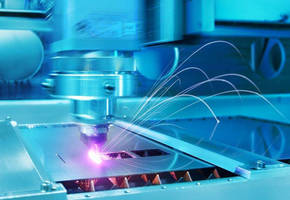BRILAMET Research Project Brought to Successful Conclusion
Share:

Precision laser-cutting technique optimized for thick metal sheets
LIMO gains expertise
Using lasers to cut sheet metal is something that has typically been handled in the realm of CO2 and fiber lasers, though this may not be the case for very much longer: Diode lasers are increasingly emerging as the light source of choice for a large number of applications, as can be seen from the BRILAMET research project that has just come to a successful conclusion.
There is a great deal of interest surrounding laser cutting, and events related to this topic often draw plenty of publicity. One recently-concluded research project in particular will likely attract even more attention, especially for applications in the sheet-metal industry, namely: the BRILAMET (brilliant high-power diode lasers for metal processing) joint research project, which was carried out between July 2012 and June 2015 as part of the German Federal Ministry of Education and Research program entitled "KMU-Innovativ, Optische Technologien" ("optical technologies in innovative small and medium-sized enterprises", promotional reference: 13N12282). During this period, the Laser Center at the Münster University of Applied Sciences (LFM) teamed up with the Dortmund-based LIMO Lissotschenko Mikrooptik GmbH to conduct extensive experiments in the area of precision cutting for thick metal sheets.
Initially, the project involved the use of a 2.5 kW high-power diode laser (HPDL) that was coupled to industrial CNC machining equipment. LIMO had used special micro-optics to optically connect the HPDL beam source modules. Through an optical fiber, the HPDL beam was then guided to the cutting head, which was also developed by LIMO. LFM and LIMO employed the "Design of Experiments" (DOE) methodology to optimize the cutting process by experimenting with different nozzle geometries and diameters, as well as with other aspects. As the project progressed, the experiments were expanded to include a 4 kW HPDL beam source, which likewise consisted of two laser units coupled together.
Among other things, the project showed that although a high-power diode laser operates at a relatively modest brilliance, it is well suitable for the rapid and precise fine cutting of 6-mm thick stainless steel (speed > 2.0 m/min., roughness Rz < 30 µm). "The key ingredient here is not only the asymmetrical laser beam geometry but also the model for predicting machining results, which was developed during the project," explains Dr. Jens Meinschien, Vice President Innovations Management at LIMO. "By making further laser beam-shaping adjustments, cutting speeds of 2.5 m/min can even be achieved with 4 kW diode lasers." But the experts at the Dortmund-based company were interested in more than just using HPDL beam sources to optimize high-precision laser cutting processes: "Over the past three years of close cooperation with the laser specialists at the Münster University of Applied Sciences, we have acquired a great deal of additional expertise," Dr. Meinschien notes in looking back on the successful collaboration. He adds: "We now know how to improve the components and, most importantly, the beam-shaping systems for kW beam sources using an adapted optical, mechanical and thermal design."
LIMO has presented the results of the project at international trade fairs and conferences as well as in trade journals, and the findings have caught the attention of experts throughout the field. The entire topic appears to be somewhat of a never-ending story for LIMO, as the Dortmund-based company is currently pursuing additional laser-cutting research alongside internationally renowned experts as part of the EU "Lashare/Nextcut" sub-project. Says Dr. Meinschien: "I am very excited to see what kind of additional expertise we can gain from this research collaboration."
About LIMO:
Since its foundation in 1992 LIMO Lissotschenko Mikrooptik GmbH has been known as one of the leading companies in laser beam shaping. At LIMO’s headquarter in Dortmund an international team of more than 240 specialists develops, manufactures and sells innovative micro-optics and laser systems. We are the only company worldwide whose core competence uniquely combines optics design with laser systems and materials processing know-how. This makes LIMO an important and reliable partner for customers in various industries, e.g. in semiconductor manufacturing, flat panel display production, medical equipment manufacturing or in the automotive industry, who are looking for unique customer-specific solutions.
Additional technical information:Â
Dr. Jens Meinschien  Â
Vice President Innovations ManagementÂ
Phone: +49 - 231 - 22 24 1 - 130Â Â Â
Fax: +49 - 231 - 22 24 1 - 140Â Â Â
j.meinschien@limo.de
www.limo.de
Press and media contact:
Susanna Siebels-Bracht
Marketing PR
Phone: +49 - 231 - 22 24 1 - 413
Fax: +49 - 231 - 22 24 1 - 140
s.siebels-bracht@limo.de




